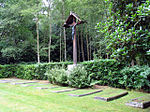
The substantial estate at Ascot was bought in 1860, using a legacy left to Dr Pusey by his mother. The chief work of the community was to be a convalescent home.
The first architect commissioned was G. G. Scott, but he handed the job over to his former pupil Charles Buckeridge (1832/3-73). According to the Ecclesiologist (1864), the ‘works were begun’ by Scott, but the design seems to have been Buckeridge’s, based on a sketch by Mother Lydia. It was to be cruciform, with a long nave for the hospital ward, transepts for the sisters’ cells, and the eastern arm for the chapel.

The Chapel was to have been Early English, with an antechapel, an apsidal sanctuary with ambulatory, and a massive central tower with an octagonal broach spire. Two chapels were to have been built over the main chapel aisles, at first floor level.
The first part built was the single-storey nave, 100 feet long, with 33 beds (one for each year of Our Lord’s life) and cots for children. Over the doorway is a relief of the Crucifixion by James Redfern. A ‘small oratory’ was built.
In 1863 the Cemetery was consecrated.

From 1864 Dr Pusey spent his vacations at Ascot, in a house called The Hermitage (now demolished).
The first part of the Priory Church was built in 1870: it consists of two bays in Norman style, the dog-tooth carving suggested by a visit by Mother Lydia to Iffley, near Oxford.
Before the aisles were built the arches were bricked up. The Church was linked to the Hospital by a ‘greenhouse’. In 1879 the ‘north transept’ (now known as St Michael’s), as planned by Buckeridge, was built, with William Butterfield as architect, to provide cells for novices. A Visitors’ Wing was built in 1884.
In 1884-6 Butterfield completed the church (using a nun’s legacy). The ‘south transept’ (south wing) was built in 1901-3, to the design of Leonard Stokes. Although a Roman Catholic, he also built the Anglican Convent at London Colney, Herts.
The Priory Church of Jesus Christ is severely simple, in banded stone. The interior has been described by Paul Thompson as ‘noble’ and ‘calm’. It features Butterfield’s only use of a wagon roof in his later years. The nave was ‘barrelled’ by ‘Bodley and (Cecil) Hare’ c.1930. It seems that Bodley embellished Butterfield’s stone reredos with painted woodwork. The carved altar frontal is in the style of Martin Travers.

Most of the stained glass is by Gibbs, but the eastern-most light on the south side (a memorial to the second Warden, Fr Suckling) is by Comper. In the South aisle is the portable altar from Pusey’s sitting-room in the old Hermitage, and above it a painting given by his biographer, H. P. Liddon. The Gallery and organ-case are presumably by Bodley.
Between 1906 and 1920 various extensions were made (including one to the ‘choir’ of the church), the Children’s Ward (St Gabriel’s) was built, and the ‘greenhouse’ was replaced by a narthex (in the style of Butterfield).
